17. Healthy
Communities plan with the environment in mind.
The
Brandon ACC North
Campus – A
Case Study in Unsustainable Design |
Our city and our province, despite their abundant claims to the contrary, continue to miss the boat when it come to taking advantage of opportunities for sustainability.
The design and management of the ACC Brandon North Campus is a case study in inexplicable choices.
Let’s start with getting there.
First let’s acknowledge that over 90% of the traffic attending this campus come from the south, along First Street.
Now let’s look at the route they MUST take.
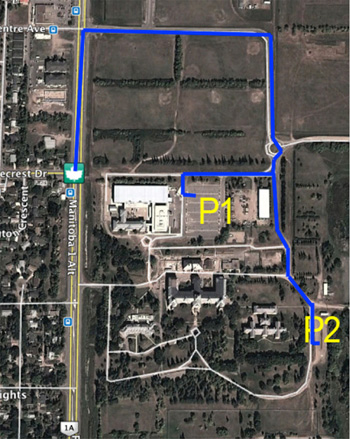
Instead of allowing a simple right turn into the grounds, students must take the long way around. Over 1 km extra driving to get to the Parking lot (#1) for the Trades Building – some distance more to the Culinary Arts (#2) lot.
On an average day there are well over 200 vehicles in these lots. That’s about 500 km of extra driving per day, not counting leaving for noon hour etc.
Why?
I’m betting there were traffic flow arguments - some plausible, and even safety issues – less plausible. I don’t know, and it doesn’t matter. The point is that I have little faith that my sorts of observations even got to the table. If they had, I think all that brainpower at hand would have devised solutions that didn’t involve MORE traffic.
What I see all across the spectrum of Government and City planning is that they haven’t even begun to filter projects and plans through the lens of the environment.
Years ago I worked for a time out of an office in City Hall. Brandon had by that time built some really nice bike and walking trails. You could bike right around the city – and I do mean around, definitely not through. To get to work from my home, I was dodging traffic all the way. The planners and engineers and trail makers just put the trails where it was convenient…FOR THEM. They are good recreational trails but we haven’t even begun to address encouraging people to take their bikes for work etc.
WHY?
Well, I think I found out why. My bike was the only one in the bike rack at City Hall. No one at City Hall biked to work.
Just guessing here – but perhaps part of the problem is that, unlike the people who designed both the Brandon bike paths and the ACC access – I’m a pedestrian, cyclist, and jogger. When you get out of your car you see stuff.
So was traffic flow and safety on First Street the reason for the big detour?
Look at that map again…
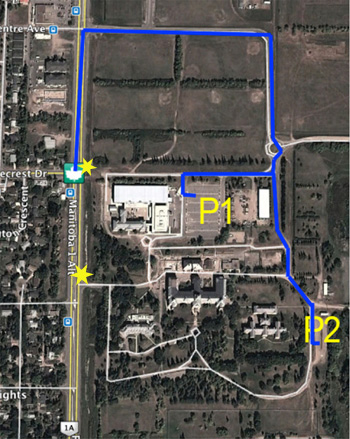
There are two places where vehicles used to access the grounds back in the good old days when it was a Mental Hospital with 100’s of residents, regular visitors and a huge staff. It seemed to work fine.
Ah, but First Street is a much busier place now. True – but I live nearby and cross the street nearly every day. It is simply ridiculous to think that with a proper turning lane, drivers couldn’t manage the simple right turn without causing mayhem. God forbid that we solve any safety issue by lowering the speed limit or anything crazy like that. Keep those cars a rolling. Vehicles coming from the north can still use the entrance at the lights, to the north.
So maybe it was the traffic flow on the grounds that was the issue?
Well I can see that argument – who wants a few hundred cars all rushing to class every morning at 8:30?
I’ve walked the route from the corner of Braecrest – east into the grounds by the Len Evans building – hundreds of times at all hours of the day. On the one side is a deserted ball diamond, on the other, a building with no access points. I just can’t believe that, especially for the Trades students, this wouldn’t be much better. And as one who has had to dodge the parade of speeding, swerving vehicles on the present route at closing time, I challenge anyone to a discussion about safety.
So I’m still a bit puzzled – honestly, I’m not being sarcastic (right now anyway). I would have loved to be at the table when this was being planned – to understand.
But that’s my point. I can’t believe they asked anyone who puts the priority on sustainability and who has had a car culture inoculation.
Let’s continue, because I think I found another piece of the puzzle.
Shortly after the first November snowfall, I was jogging along my usual route along the great detour making my way to the grid road leading east (the top blue line on the previous map). As I approached the roundabout (see the * on the next map…) I noticed a truck approaching from the south. Up to that point there is a nice wide shoulder on the road but as one enters the roundabout the shoulder disappears. So I hugged the edge of the lane. Just as the truck entered the roundabout the driver decided that, what with the nice slippery streets and all, why not step on it and enjoy swerving into the turn. I leapt for my life, obscene gestures may have been exchanged, and I was left reflecting about how our governments are really not encouraging us to walk or bike.
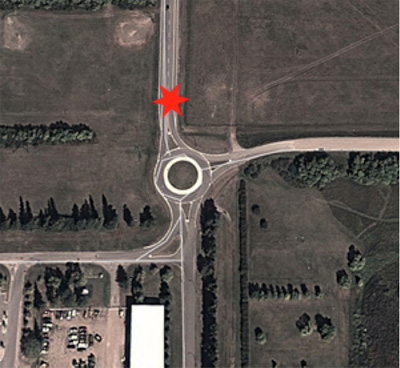
I also reflected on how we like roundabouts. I like roundabouts. They are a cool, inexpensive, traffic solution if pedestrian traffic is not a factor - then they are a disaster. But they are trendy these days.
And I’m sure that is why this roundabout is there. It must have seemed the cool, forward thinking way to go.
This one is special.

This is where I was when I encountered the truck. See what I mean? I usually just take the grassy route for the next bit. But see how they have thoughtfully placed a sidewalk around the interior of the roundabout? Nice touch. If you could just survive the crossing to that sidewalk you could go round and round…
As happens, someone designed this little beauty for his or her own amusement, certainly not to facilitate any pedestrian activity. It’s a sidewalk to nowhere. And a nice wide expensive one.
As funny as this seems – and I think it’s hilarious – there is a dark side to all this.
We are wasting millions of dollars doing the wrong things – while we complain that we have no money to do the right things.
But wait - maybe someone has been using it.
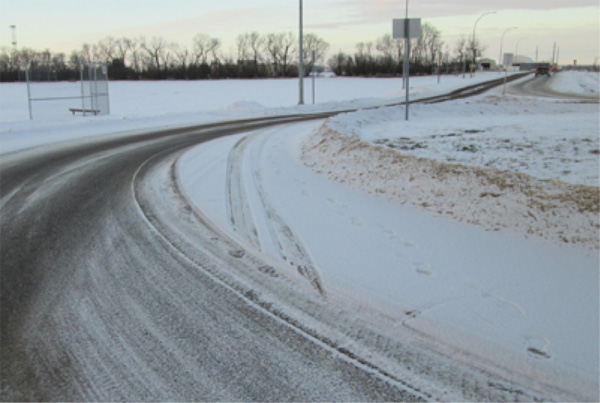
Yes indeed – traffic in and out of the Trades Building often takes a short cut over the sidewalk– maybe to make up for the extra kilometres they have to drive each day? Nice that the curb is sloped so it doesn’t interfere. Sometimes they just go the wrong way for fun as they race out.
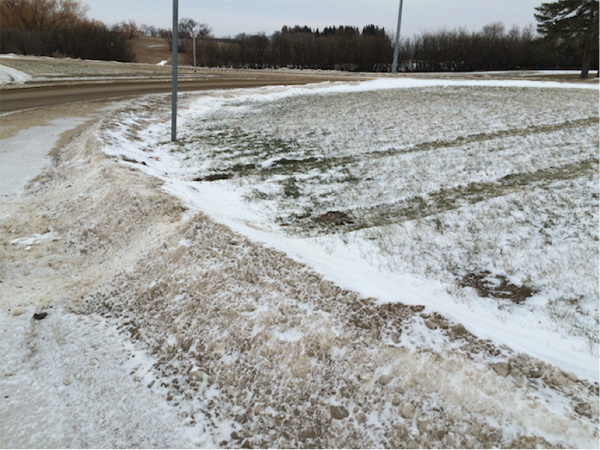
Or what the hell – why go out of your way at all? Just cross straight ahead on the grass.
I see this sort of thing all over our city. Now that half the vehicles on the road are oversized, noisy, gas hungry, dangerous pick-up trucks, we see damaged curbs everywhere. My Ford Fiesta would balk at the thought of jumping a curb. No problem for a Ram 150. Most people don’t buy off-road vehicles because of their love of nature.
Again – hilarious – if it wasn’t for the fact that by building this beautiful, wide-open, access road – we have just encouraged drivers to use it a speedway.
In the real world, people who are able to get past the indoctrination of car culture, know that you don’t cure traffic problems by building more roads. You do it by encouraging alternatives to car travel and placing better restrictions on careless and dangerous drivers.
The access for vehicles is only the more readily obvious part of our story.
Why have I never seen a student biking or, perish the thought, walking, to class?
Well, for starters, one just might question the wisdom of establishing an educational facility several kilometres from where MOST PEOPLE live… on the other side of a river, up a steep hill, with a walk path that goes HALF WAY so that the final uphill part is on the shoulder of a road and you get that extra lung full of exhaust to start your school day.
But hey – that’s how we do things. We don’t consider sustainability when we make important decisions. We assume that people have cars. We design around that reality instead of asking what the future SHOULD look like.
Well, although we have spent quite a bit of money making sure cars get the opportunity to burn a bit of extra gas and run over a few pedestrians on the way to school, we haven’t spent too much on accessibility for anyone on foot.
You’ve seen my maps about the vehicle route – but surely pedestrians can take a more direct route to class.
Well yes… sort of.
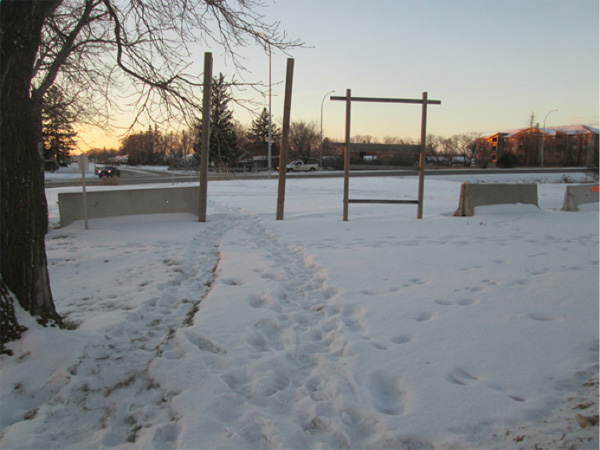
If you are one of the 20 or so students attending the multi-million dollar Culinary Arts program you can get off the bus and take this route to class. Not bad if you’re on the bus that stops on this side of the street.
If you are one of the 200 or so who are attending Trades classes – there seems to be a bus that takes you right there (along the giant detour – because fuel is cheap – and the transit system is flush with cash). I saw a person on that bus once – wish I’d had my camera.
But for whatever reason, a few people do walk in from the street, maybe they live nearby. Maybe they like a challenge.
They get to use this state-of-the-art walkway if they want a direct route from Braecrest to the Trades Centre.
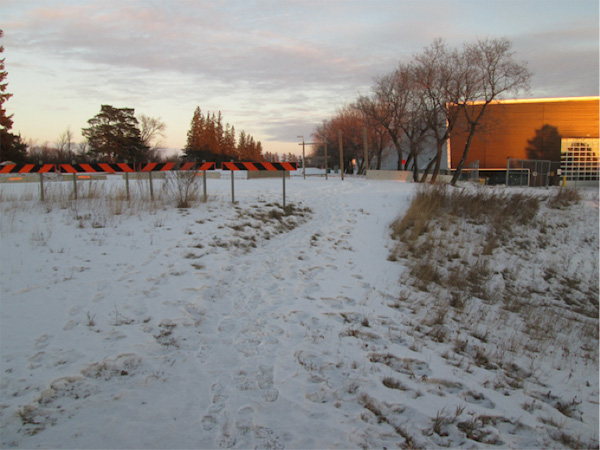
Here is the view from the street. Notice – to my disappointment …no roundabout.
Once you’ve made it onto the grounds however there are sidewalks. Lots of them. Ice free, in the winter, leaf free in the summer. Lovingly maintained.
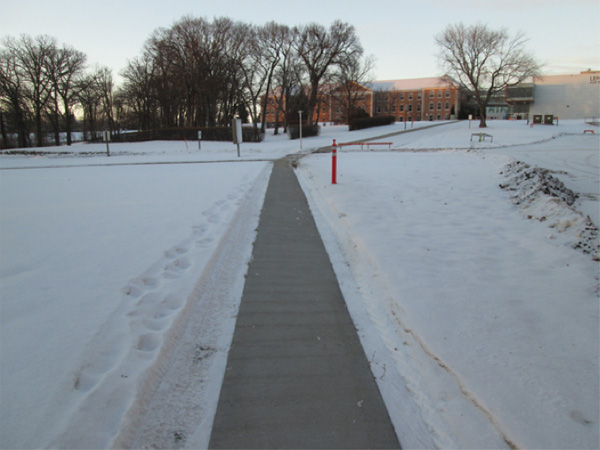
Walking the streets of Brandon in winter is a risky thing – by the time anyone clears a walkpath or sidewalk the coating of ice left behind just makes it worse.
Not so for pedestrians, rare as they are, on the ACC grounds. The maintenance staff seem to prefer ATV’s, and the 200 Trades students get to park right across from their classrooms. Planners, in their wisdom, have seen to it that the Culinary Arts students must park nearly half a kilometre from their classroom, perhaps to justify sidewalk maintenance.
Design Decisions – Where it all Begins
Exploring the design of the grounds through the lens of sustainability is a starting point. But to really understand why we are where we are, one needs to take a look at some earlier decision-making.
Most of us would agree that environmentally unsound practices are wasteful in terms of the health of the earth, but that solutions can be difficult. People need to get to work, to heat their homes, go for groceries. Alternatives to the carbon intensive path we have taken will not come easily.
But what really gets me is that we haven’t started to do the easy things that not only would help, but would give us hope that change can happen.
I think that the very decision to convert an aging Mental Hospital to a Community College Campus was arrived at for the wrong reasons. I admit that hindsight is involved in that opinion. We could keep arguing about it, but the decision was political, rather than environment, or even educational.
As a graduate of the local University I can’t help but be a bit amused to revisit that place – once spacious with lawns and a square of grass separating the residence and the other buildings – now with an extra five or six building packed in. I liked it then and I like it now. Students can still walk downtown. It has a busy, modern, urban feel. Density can be good.
Contrast that with the verdant spaciousness of the ACC Campus, reminiscent of so many Hollywood productions set in fictitious University Towns.
That comes with an enormous price – and one that has nothing to do with educational opportunity or educational excellence.
I know this rant might seem like a digression – but I say that the decision making from the start sets the stage for the decision making that continues. They didn’t properly consider sustainability in the complete sense of the word. The focus was on something else.
And let me say this: Conserving heritage buildings can be a very earth-friendly option, but it is only sustainable when the buildings can serve a viable purpose, and are part of a workable plan.
But we certainly don’t need all that space and it should be sold or put to other use. Pasture perhaps – no – too much methane. Vegetables?
Then we need the management of this and all government funded projects to be compelled to develop some environmental smarts. We to have everyone involved to learn to filter all projects through the environmental checklist test. It starts at the top.
It is not just mines and mega-projects that should have to meet some kind of sustainability standards. It should be everyday procedure in all things.
 |
 |
 |